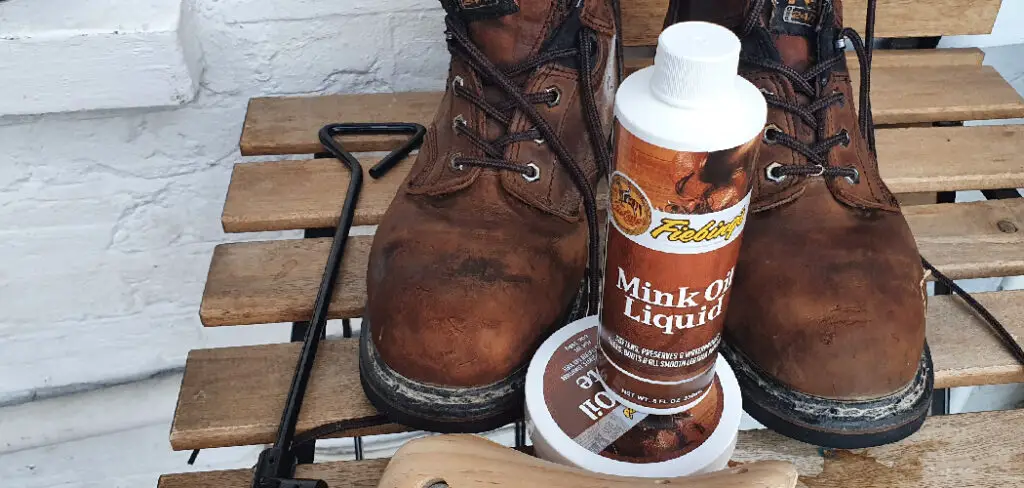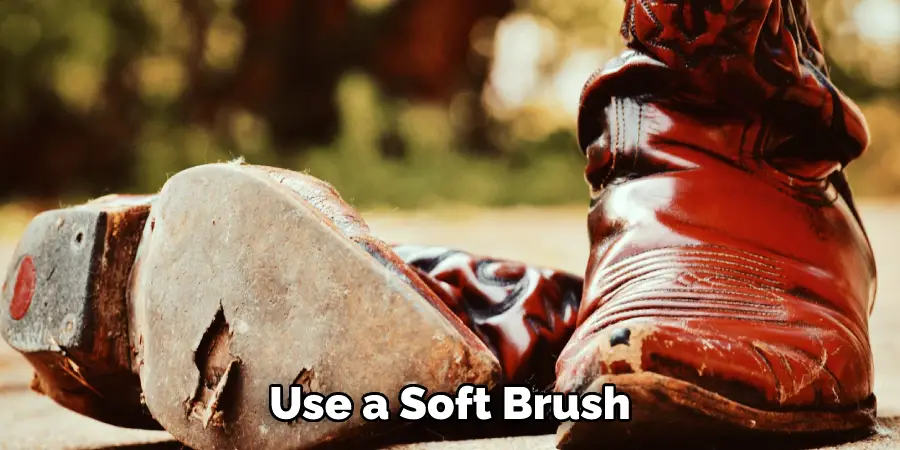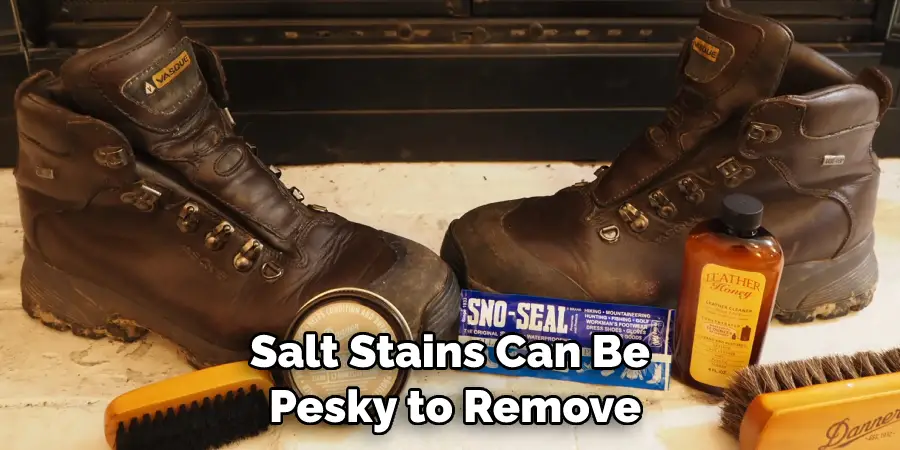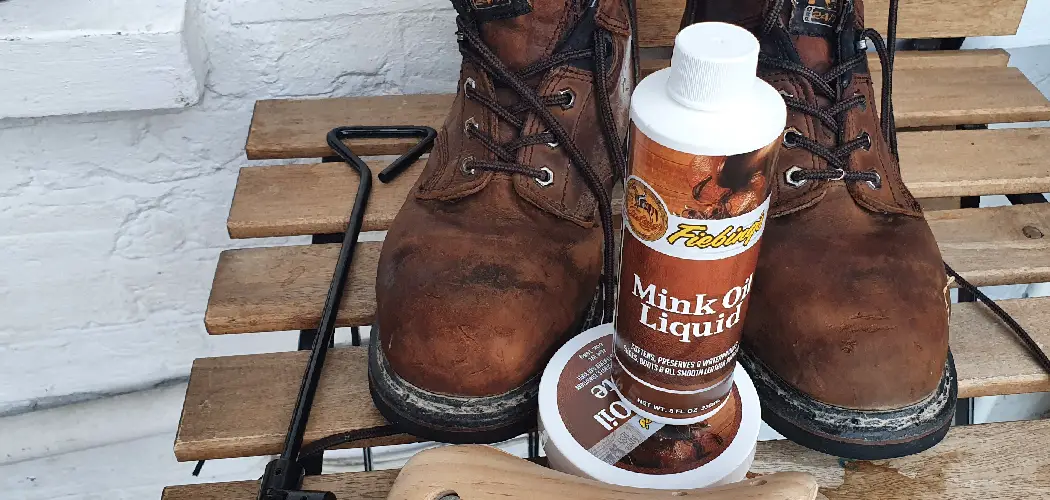Do you have a pair of leather work boots that you rely on day in and day out? If so, ensure you properly care for them to extend their life.
There’s nothing like a good pair of leather work boots. They’re tough, durable, and last for years when taken care of properly.
Leather work boots are a staple in any worker’s wardrobe. Caring for leather work boots is important to keep them looking good and performing well. There are various ways to care for leather work boots, some of which are more effective than others. In this post, we’ll discuss the best way how to care for leather work boots so that they last as long as possible.

However, they can be difficult to keep clean and look good. Here are a few tips on how to keep your leather work boots in great shape. We’ll also share some products for cleaning and protecting leather shoes. Let’s get started!
What are the Benefits of Wearing Leather Work Boots?
Leather boots are popular for a reason. They provide protection for your feet and are durable enough to withstand tough work conditions. Leather boots also offer some benefits that other materials might not, such as:
- Water Resistance: Leather is naturally water-resistant, making them a great choice for wet work environments.
- Breathability: Leather allows your feet to breathe, minimizing sweat and odor buildup.
- Durability: When properly cared for, leather boots can last for years.
- Appearance: Leather has a classic look that never goes out of style. Plus, it looks better with age and develops a unique patina over time.
- Longevity: Leather is a tough material that can withstand heavy wear and tear for years, making them a worthwhile investment.
So, leather boots are a great choice for work and everyday wear. But, they need proper care and maintenance to keep them performing well and looking good.
10 Easy Steps on How to Care for Leather Work Boots
Regularly cleaning your leather work boots will extend their lifespan and keep them looking good. Here’s how:
Step 1: Removing Any Dirt or Debris
First, use a soft brush or cloth to remove any dirt or debris from the surface of the boots. This will prevent any particles from getting trapped in the leather during cleaning. You can also use a damp cloth to wipe away any surface dirt or grime.

Step 2: Cleaning the Leather
Next, use a mixture of warm water and mild soap to clean the leather. A soft cloth or horsehair brush works well for this step. Make sure to clean in circular motions and avoid scrubbing too hard on the leather. Rinse off any excess soap with a damp cloth and let dry completely before moving on to the next step.
Step 3: Conditioning the Leather
Once your boots are dry, it’s time to condition the leather. This will moisturize the material and prevent cracking over time. Use a good quality leather conditioner and apply it evenly with a soft cloth, paying extra attention to any creases or folds in the leather.
Step 4: Protecting Against Water Damage
Use a waterproofing spray on your leather work boots to prevent water damage. This will keep them looking good and protect them against rain and other moisture. Make sure to follow the instructions on the product for proper application.
Step 5: Storing Your Boots
When not in use, store your leather boots in a cool, dry place away from direct sunlight. You can also stuff them with newspaper to maintain their shape while they’re being stored. Another option is to invest in boot trees, which are specially designed to insert into the boots and help maintain their shape.
Step 6: Dealing With Scuffs or Scratches
To deal with scuffs or scratches, first, try rubbing the affected area with a soft cloth and leather conditioner. If this doesn’t work, you can also try using a matching color shoe polish or wax to touch up any imperfections. Make sure to test the polish or wax in an inconspicuous area before applying it to the entire scuffed or scratched area.
Step 7: Dealing with Salt Stains
Salt stains can be pesky to remove, but there are a few tricks you can try. One option is to mix equal parts white vinegar and water and apply it to the stain with a cloth, letting it sit for an hour before wiping it off. Another option is to rub the stain with some lemon juice and let it sit overnight before wiping it off in the morning. But, be sure to spot test in an inconspicuous area before trying either method on the entire stain.

Step 8: Deep Cleaning
Start removing any laces or inserts to deep clean your leather boots. Then, use a mixture of warm water and mild soap to clean the leather, followed by conditioning and waterproofing as usual. Next, use a toothbrush or soft brush to scrub any tough dirt or stains on the shoe’s sole. You can also apply a small amount of baking soda onto the stain, letting it sit for an hour before wiping it off with a damp cloth.
Step 9: Dealing with Odor
To remove odor from your leather boots, try sprinkling some baking soda inside and leaving them overnight before shaking them out in the morning. You can also try mixing white vinegar and water to wipe down the interior or placing them near an open container of activated charcoal overnight to absorb any odors.
Step 10: Professional Cleaning
If you have particularly tough stains or want a professional touch, it’s always an option to take your leather boots to a shoe repair shop for cleaning and maintenance. This can be less time consuming and ensure that your boots are properly taken care of.
Overall, regular cleaning and maintenance of your leather work boots will keep them looking good and performing well for longer. Following these steps will ensure that your boots stay in tip top shape. Happy cleaning!
5 Additional Tips and Tricks
- Polish your boots regularly to keep them looking shiny and new.
- Condition the leather with a leather conditioner to keep it soft and supple.
- Use waterproofing spray or cream on your boots to protect them from water damage.
- Deodorizing spray or powder can help prevent unpleasant odors in your boots.
- Let wet or damp boots dry naturally, away from heat sources, to prevent shrinking or cracking of the leather.
These tips and tricks will keep your leather work boots looking and feeling great for a long time. Happy polishing!

7 Preventive Care Tips
- Make sure to clean off any dirt or mud after wearing your boots to prevent long-term damage.
- Alternate between different pairs of boots on different days to allow them time to dry fully and prevent wear on one specific pair.
- Replace laces and inserts regularly for proper support and comfort.
- Use a shoe horn when putting on your boots to avoid stretching the leather in the wrong places.
- Store your boots in a cool, dry place away from direct sunlight when not in use to preserve their shape and condition.
- Avoid wearing your boots in wet or snowy conditions to prevent water damage.
- Have your leather work boots professionally cleaned and maintained at least once a year for optimal care.
Prevention is key in keeping your leather work boots in good condition for a longer period of time. Following these tips will ensure that your boots last for many years. Happy protecting!

What Are the Best Products for Cleaning and Protecting Leather Work Boots?
Some recommended products for cleaning and caring for leather work boots include leather cleaners, conditioners, waterproofing sprays or creams, deodorizing sprays or powders, shoe horns, and polishes.
It’s important always to use products specifically made for leather to ensure that the material is not damaged. Popular brands in this category include Money worth & Best, Bick more, Lincoln Stain Wax, and Kiwi. It’s also a good idea to ask a professional at a shoe repair shop for their recommendations on products.
Can You Modify Your Leather Work Boots?
Generally, it is not recommended to modify leather work boots as this can potentially damage the material. If modifications are needed for a specific purpose or job requirement, consulting with a professional at a shoe repair shop before making any changes is advisable.
It’s also important to keep in mind that modifying your boots may void any manufacturer warranties. Overall, taking proper care of your leather work boots and ensuring they fit correctly will usually eliminate the need for modifications.
Frequently Asked Questions
Should I Oil My Leather Boots?
The condition of your boots will dictate whether or not you should oil them. If your boots are in good condition and have not worn out significantly, you may choose not to oil them. However, if your boots are old, neglected, or have seen significant wear and tear, oiling them can help restore their lifespan and protect them against rust and decay.
When deciding whether or not to oil your boots, it is important to consider their condition. If your boots are in good condition and have not worn out significantly, you may choose not to oil them. However, if your boots are old, neglected, or have seen significant wear and tear, oiling them can help restore their lifespan and protect them against rust and decay.
If you do decide to oil your boots, there are a few things to keep in mind. First, make sure that the oil you use is appropriate for the type of leather boot that you are oilsing. Second, be sure to apply the oil evenly to the entire surface of the boot. Finally, allow the oil to dry before wearing the boots.
How Do You Preserve Leather Boots?
There are a variety of ways to preserve leather boots, depending on the type of boot and the desired outcome. For example, if you only want to keep the boots for a short period of time, you can polish them using a special polish or treatment. If you want to keep the boots for longer periods of time, you can treat them with a protective coating or sealant. Alternatively, you can dye them or apply a layer of fabric protector to make them water-resistant.
Whatever the method, it is important to follow the manufacturer’s instructions carefully to ensure that the boots are preserved in the way that best suits your needs. Additionally, it is important to store the boots in a dry place away from direct sunlight and heat, as these elements can damage the leather.
Can I Use Vaseline on My Leather Boots?
There is some debate as to whether or not Vaseline can be used on leather boots. Some say that Vaseline may cause damage to the boots, while others believe that it can help protect them from moisture and insect bites. It is ultimately up to the discretion of the individual as to whether or not they want to use Vaseline on their leather boots. It is always best to test a small amount of Vaseline on a hidden section of the boot first to make sure it will not damage the boot. If you are unsure about whether or not Vaseline can be used on your leather boots, it is best to consult with a professional or other knowledgeable source before making any decisions.
Is Coconut Oil Ok for Leather Boots?
There is limited scientific evidence to support the claim that coconut oil is harmful or incompatible with leather boots. However, based on the information available, it seems likely that coconut oil would be safe for use on leather boots provided that the oil is applied sparingly and in a manner that does not cause damage to the boots. Coconut oil is a natural oil that is derived from the fruit of the coconut tree. It has been used for centuries as a moisturizer, skin care product, and hair treatment, and has been shown to be effective at treating a variety of skin conditions. It is also known to be beneficial for maintaining leather boots, as it helps to prevent water and dirt from damaging the surface of the boot. In general, it seems unlikely that using coconut oil on leather boots would cause any harm or damage.
Conclusion
While it may seem like a lot of work to care for your leather work boots properly, it is definitely worth it in the long run. With proper care, your boots will last longer and continue to look great. Just remember to clean them regularly, condition them often, and store them correctly when they’re not being worn.
Now that you know how to care for leather work boots, you can help them last longer and look their best. With just a little bit of regular maintenance, your boots will stay in great condition year after year.
Following the steps above, your leather work boots should last many years. With proper care, they will only look better with age.

